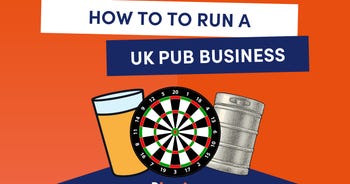How to price your product: The ultimate guide to easy product pricing
Pricing your product is one of the biggest decisions you’ll make as a business owner and getting it right can affect how your business is run.
From sales to competitor pricing to business goals, the selling price for your product isn’t something you can just take with a pinch of salt — it can ultimately make or break your turnover and success.
No matter whether you sell a wide range of products or you’re a small business just starting out, we can help. To make the process that little bit easier — and help streamline your pricing strategy — our handy guide is here to help walk you through product pricing.
What does it mean to price a product?
There’s a lot that goes into a pricing strategy, touching on everything from your business finances to competitor analysis, market trends and more. But, whether you’re launching a new business or product, pricing simply means the price that you’re going to sell your product or service at. However, be careful of the two main pitfalls you can encounter when pricing: underpricing and overpricing.
Underpricing
Underpricing means setting a price less than the value of the item. Underpricing your products can have a disastrous impact on your bottom line. And, while it can seem like a good idea to help entice customers and beat competitors, it just simply doesn’t work in the long run.
Overpricing
If you overprice a service or product, this means that you’re selling it for considerably more than what it’s worth — which can be just as detrimental to your business as underpricing.
Pricing items beyond the customer’s desire to pay can have a serious impact on sales and can put shoppers off buying in the future.

What factors should you consider when pricing?
While you don’t want to charge less than you’re worth, you want to make sure that you don’t price yourself out of the market. There are five factors to consider when pricing your product or service:
1. Costs
Before you set your pricing, you need to make sure that you’re financially informed. You’ll have to work out the costs involved with running your business such as:
- Fixed costs — The expenses that will come out every month regardless of the number of sales you’ve made.
- Direct costs — These are the expenses that you incur by producing, manufacturing and selling your product or service.
Knowing your monthly expenses can help you make informed decisions about your pricing.
2. Customers
You need to know what your customers want from your product or service. Ask yourself:
- Are customers driven by the cheapest price or by the value of the product they’ll receive?
- How big a factor does price play into their purchasing decision?
- Are your current customers buying high or low-end products?
Using this information will help you determine whether your price is right, the level of service you should be offering and whether you’re targeting the right market and demographic.
3. Positioning
Once you’ve understood your customers and the costs associated with your product, you need to look at your positioning. Regardless of your current position in the marketplace, you need to think about where you want to be. Do you want to be a high-end brand in the industry or the cheapest? Or would you rather be somewhere in the middle? Knowing your positioning can help you attract the right customers to your brand and give you an idea of your ideal pricing.
4. Competitors
Regardless of whatever industry you’re in, you’re always going to have competitors. Whether it’s fast fashion, insurance or even selling a cake, you need to ask yourself why people are shopping at your competitors. Think of things like:
- How much are your competitors willing to pay for a product? How much are they willing to sell it for?
- What level of service are they offering for their product?
- What customers are they attracting with that price? What’s their age range?
- How are they positioned in the market?
Answering these questions can help give you an industry benchmark about where you should roughly price your products at.
5. Profit
While your business may be a passion project, you need to make sure that you’re actually turning over a profit. But, to do this, you need to ask yourself “how much profit do I want to make?” Business owners tend to look at what other businesses are pricing their products at, and then produce a competitive number — which can sometimes be their downfall.
How should I price my products or service?
Taking these factors into account, there are three straightforward steps to help you calculate a sustainable price for your products or service.
1. Add up your variable costs
Variable costs are expenses that increase or decrease depending on the level of production you have.
If you order products, you’ll have a more straightforward answer as to how much each unit of product will cost. If you make your products, however, you’ll need to look at the costs of:
- Raw materials — Any basic material that is used to produce goods.
- Labour costs — The sum of all wages paid to employees, as well as the costs of benefits and payroll taxes.
- Overhead costs — The ongoing costs it takes to keep the business running. This can be anything from rent, admin costs, utilities, insurance and more.
However, you shouldn’t forget the time that it takes for you to make the product, too. To price your time, set an hourly rate you want to earn from your business and then divide this by how many products you can make in that time.
For example, you might incur these costs for each product:
- Costs of goods £3.00
- Production time £2.50
- Packaging £1.60
- Shipping £3.70
- Promotional materials £0.70
- Total £11.50
- The total per-product cost is £11.50.
2. Add up your fixed costs
Fixed costs are any expenses that aren’t directly impacted by the volume of production, so whether you sell 100 or 1,000 products, the expenses will stay the same.
You can easily gather all of your information on fixed and variable costs and use a break-even calculator. This lets you see how many units of a single product you’d need to sell to break even at your chosen selling price. In general, a business with lower fixed costs will have a lower break-even point of sale and profit is counted as anything above or beyond the break-even point.
3. Add an ideal profit margin
A profit margin will roughly estimate to a degree the money that your company makes. Usually, it’s expressed as a percentage and measures the amount of profit made per unit of currency of revenue gained.
In theory, you can add as much profit margin onto your product as you want, but you have to be realistic and make sure that you have a competitive price once you’ve taken your desired profit into account. While profit margins do differ depending on the industry that you’re in and the market you’re trying to tap, usually you’ll find that:
- 5% — Is too low.
- 10% — Is considered healthy.
- 20% — Is too high.
How to conduct a price analysis
Whether you’re developing your strategy, running market testing or developing new product ideas, you’ll more than likely need to conduct a pricing analysis.
Price analysis is a process of evaluating your current pricing strategy against market demand. The goal is to identify any opportunities for pricing changes and improvements with the analysis being conducted every year or two. There are four main stages of a price analysis:
1. Determine the true cost of your product or service
To conduct your price analysis, you’ll first have to determine the cost of your service or product. You’ll again have to include both your fixed and variable costs, add them together and then subtract them from the price you’ve already set or will be setting.
2. Understand your target market and customer base
Focus groups, surveys and questionnaires can be helpful tools when it comes to determining how the market responds to a pricing model. Sending out a simple email questionnaire to your customers can give you an easy glimpse into what your customers value and how much they’re willing to pay for your product or service.
3. Analyse the price that’s set by your competitors
When it comes to looking at your competitors, there are two sides you can compare: your direct competitors and your indirect competitors.
Direct competitors are similar businesses that sell the exact same product(s) as you. They’re likely to have competitive prices so they should be high on your priority list to review. Indirect competitors are businesses that sell an alternative product(s) that can be comparable to what you sell. Essentially, if a customer is searching for a product but it’s out of their price range or not available, they may go to an indirect competitor to get a product that’s similar.
4. Review legal and ethical constraints to cost and price
When conducting your price analysis there are two things you need to steer clear of: price-fixing and predatory pricing.
Price-fixing
Price fixing is an agreement among competitors to either raise, lower, maintain or stabilise price levels. When consumers buy a product, they expect that the price has been made on the basis of supply and demand, not by an agreement among competitors.
Predatory pricing
Predatory pricing is the illegal act of setting prices low in an attempt to eliminate the competition and create a monopoly. A monopoly is a dominant position of an industry or sector by one particular company, meaning that other businesses don’t get a fair chance in the market.
Deciding when to raise or lower the price
For most product prices, one size doesn’t fit all and you can only go so far pricing your products based on a markup cost. Your price will vary depending on a number of factors like:
- What competitors are charging
- What the market is willing to pay
- Socioeconomic changes
- Changes in buying habits
- Supply and demand fluctuations
But, this opens the door to raising or lowering your prices for your products and services, because how do you know when it’s the right time?
Raising the price
You should always be testing new offers, prices and benefits on your website to help sell your product at a better selling point. The best way to do this is by testing new offers each month — raise the price and offer a new, unique bonus or additional service for your customers.
From this, measure the increase or decrease of the product(s) sold and the total gross profit that’s generated.
But, be sure not to alienate your existing customer base by raising your prices too high. Rather than have a sudden increase, have a strategic plan over the coming years to gradually increase your prices by 5 - 10%.
Lowering the price
In some cases, you may realise that you’ve missed your target audience by raising your prices too high. If you’ve got a lot of deadstock, consider lowering the price to make way for any new stock that you might have coming in. Alternatively, you can always choose to discount your products or give customers a free incentive in order to generate traffic to your storefront or website.
How much profit should I make on a product?
As a general rule of thumb, the average gross profit margin for retail is around 53%. If your business is located within the retail sector, then aim to keep your profit margins around this number.
How to price your products with Bionic
Deciding on your pricing strategy is no easy feat, but you need to make sure that you’re pricing your products properly. From conducting a price analysis to deciding when to lower your prices, your product price is one of the most important things you need to get right with your business.
Speak to the Bionic team today to find out more about Business Insurance or check out our handy guides to help you with all of your business needs.







